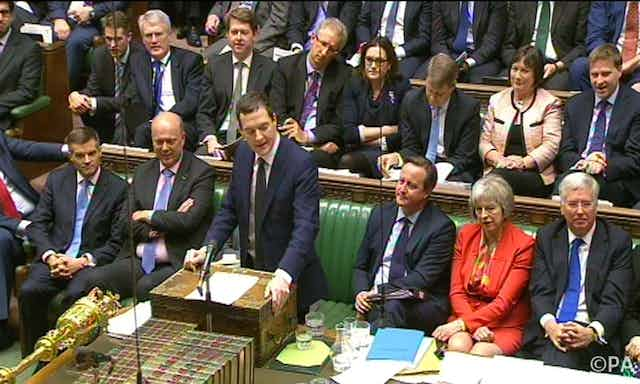George Osborne always plays the role of the smiling conjurer who pulls the rabbit out of the hat and steals the scene with aplomb. In his 2015 spending review and autumn statement, the surprise announcement was that cuts to tax credit will not be as stringent as expected – although housing benefit claimers are the losers. Concealed within the chancellor’s hat are cuts of more than 50% in grants to local government and tense optimism about the growth, employment and pay forecasts on which everything depends.
The chart below gives the main winners and losers in the spending review over the period up to 2019-20. Cuts are legion. The winners are the big players – the NHS and pensions – both accounting for about a fifth of total spending – which receive real increases of 3 to 4%.
Pensioners will benefit from the transition to the new flat-rate pension from next April onwards, increasing spending in this area by some 4%.
International development has a 21% increase, although some of the new money will be spent to aid security objectives and some in the UK on Syrian refugees. The new Single Intelligence Account for the security services also got a 17% increase and the Cabinet Office a 4% increase, but all are small players, together accounting for a little over 3% of total spending.
The middle-sized defence budget (about 5% of total spending) gains 2.3% – which reverses the downward trajectory of recent years.
Low-waged earners – including those on the government’s new “living” wage to be introduced next year – can take some relief from the fact that the widely-trailed cuts to tax credit will not be introduced. Under the plans, Osborne’s “welfare cap” – a limit on the amount to be spent on welfare – will be breached for the next three years, although spending will fall to the cap level by 2019-20, when it will be some 5% lower than it is currently.
In addition, housing benefit faces further cuts, which reduce the amount paid to renters in social housing, so that benefits will in many cases not cover rent.
Everyone else is a clear loser, and the Treasury demonstrated that “we are all in this together” with a 24% cut. The other big losers are the small departments of environment (15%) HM Revenues and Customs (18%), the local government communities budget (29%), transport (37%) and the Department for Business, Innovation and Skills at 17%. The devolved administrations in Wales, Scotland and Northern Ireland received cuts of 4 to 5%.
Massive inequalities for local government
Local government is unfortunately omitted from the Treasury’s summary of key announcements, which is confined to central government departments. But local government accounts for nearly 10% of spending and is credited with an increase of 22% in locally raised revenues. In return for this, they received by what is far and away the largest cut of all, of 56% in central government support to local government.
The settlement is at the limits of what can be achieved.
The overall local government spending cut is presented as 6.7%, on the assumption that councils will make up the shortfall locally. The means offered are: the retention of the proceeds of the sale of assets (mainly of land and housing) and the powers to vary the business rate and to increase council tax by 2% to fund social care. There is also some extra funding for local care and house-building programmes, and efficiency savings through devolution of responsibilities to elected authorities.
Central government support for councils totals some 28% of spending, but the amounts gained by individual councils vary from nearly half to about 10% of their expenditure. In general, councils with larger central support tend to be those in deprived areas and with a larger proportion of older people. These are the councils which face the heaviest demand and they will find it hardest to raise revenue locally because the money is simply not there.
The Local Government Association points out that councils have already experienced a cut of nearly 30% since 2010. In the areas most harshly affected some may well fail to meet statutory responsibilities in providing care for vulnerable children and adults.
Will the gains be sustained?
In relation to the NHS, the increase over the period just reaches the minimum expert assessment of what is needed and assumes some £22 billion in efficiency savings. The NHS has made huge savings in recent years and it is very unclear whether this pressure can be sustained indefinitely.
It is also unclear how the expected gains of at least £5bn of extra tax revenue will be achieved as HMRC experiences further cuts of 18% and already faces problems in retaining highly paid staff.
The predictions for growth, employment, wage levels and short-term benefit levels which underlie the whole plan may prove to be optimistic. The Office of Budget Responsibility (OBR) predicts government accounts will return to surplus by 2019-20. This is what makes it possible to mitigate the cuts to tax credit claimants and still achieve spending targets.
But the future is always uncertain and OBR’s growth estimates exceed the average of independent forecasters from 2017 onwards. The chancellor may be pushing his luck.

